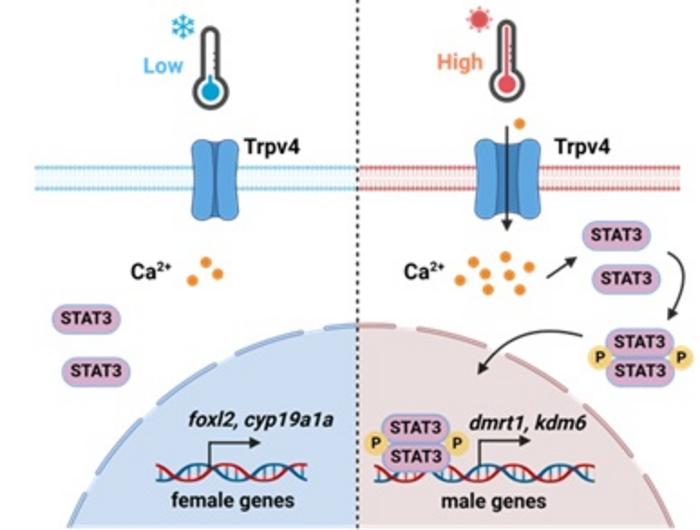The ricefield eel, scientifically known as Monopterus albus, holds a unique position within the realm of freshwater fish as it stands as the sole species exhibiting protogynous hermaphroditism. This means that individuals can change sex from female to male during their life cycle. The processes and mechanisms that underpin this fascinating biological phenomenon have piqued the interest of scientists for decades, yet the precise molecular and environmental factors that trigger such a change have remained largely obscure.
Recent research, however, has shed light on this enigmatic subject, revealing a temperature-induced mechanism that facilitates sex reversal in these remarkable eels. A collaborative study conducted by a team of researchers from China, published in the journal Water Biology and Security, provides intriguing insights into how environmental factors, particularly temperature, influence the sex determination pathways in ricefield eels. This newly identified mechanism not only enhances our understanding of sex determination in aquatic organisms but also opens avenues for further research into environmental impacts on sexual development across various species.
The study, spearheaded by leading researcher Yuhua Sun, demonstrates that elevated temperatures can provoke the expression of male sex determination genes within the ovarian tissues of ricefield eels. This remarkable discovery hinges on the role of a cation channel thermosensor protein known as Trpv4. It is particularly significant since Trpv4 governs calcium influx into cells, serving as a critical mediator between temperature stimuli and the complex cascades of sex determination signaling pathways. The implications of this finding extend beyond mere academic interest, as they imply that the manipulation of environmental conditions such as temperature could influence sex ratios in aquaculture, which is particularly important for species of economic relevance.
The study outlines that prior research had already established a correlation between hormone levels and sex determination gene expression during sex reversal events in ricefield eels. Furthermore, environmental parameters—temperature, light exposure, and pH levels—are known to influence the timing and nature of sex changes. What stands out in this fresh study is the emphasis on temperature as a direct trigger for genetic expression changes, thereby underscoring the intersection between environmental dynamics and biological processes.
One notable focus of the recent findings is the relationship between DNA methylation patterns and the expression of sex determination genes during sex reversal. It has been suggested that the epigenetic landscape of the eel’s genome is adaptable, altering in response to environmental fluctuations. This notion aligns with the broader understanding in biology that gene-environment interactions play critical roles in developmental processes. According to Sun, the hypothesis revolves around environmental signals instigating modifications to the genomic epigenetic state, leading to changes in the transcriptional activity of sex-related genes and, ultimately, to sex change.
While the research contributes significantly to the existing body of knowledge, it raises several pivotal questions that remain unanswered. Scientists are eager to determine which specific environmental factors impose the most substantial influence on sex determination. Additionally, understanding how such cues are detected and transmitted within the cellular architecture to instigate hormonal and genetic responses is pivotal for comprehending the full breadth of the sex reversal phenomenon in ricefield eels.
As temperature is shown to induce male-specific gene expression in the ovarian tissue of ricefield eels, the scientific community is coming to appreciate the integral role of Trpv4 within this mechanism. This protein belongs to the transient receptor potential (TRP) channel family, known for their modulatory role in various physiological processes, including sensation and metabolism. The identification of Trpv4 as a crucial player in temperature-mediated sex determination offers a fascinating glimpse into the evolutionary adaptations that have allowed such a unique reproductive strategy to develop in ricefield eels, coupling a thermosensory response with sex determination.
The advancements outlined in the study may have profound implications for aquaculture practices involving ricefield eels, which are economically significant in various regions. The control of environmental conditions, specifically temperature regulation, could provide a tangible method for influencing breeding outcomes, enhancing productivity, and ensuring sustainable practices in aquaculture. By harnessing these findings, practitioners can potentially develop strategies that favor desired sex ratios, thus optimizing breeding programs and improving the sustainability of eel farming.
As the researchers continue to explore these intricate dynamics, it becomes evident that the pathways involved in sex determination are not solely genetic but are deeply interwoven with the environment. The interplay of external cues and internal genetic programming reflects the complexity of biological systems and highlights the critical nature of environmental stewardship in the preservation of biodiversity. As climate change and habitat fluctuations become more pronounced, understanding these connections will be increasingly vital.
In summary, the findings from this recent study on the ricefield eel contribute significantly to our understanding of the mechanisms of sex determination in aquatic organisms. By elucidating the role of temperature and the Trpv4 channel protein, scientists are beginning to unravel the complexities of environmental influences on sexual development, paving the way for future research that will further clarify the interplay between genetics and the environment in shaping reproductive strategies. The potential applications of these findings in aquaculture could help ensure the sustainability and efficiency of fish farming practices going forward, promoting ecological balance while supporting economic growth.
Subject of Research: Animals
Article Title: A temperature-induced sex reversal mechanism in ricefield eels.
News Publication Date: 2025
Web References:
References:
Image Credits: Yue Ou and Yuhua Sun
Keywords: Life sciences, Organismal biology, Marine biology, Developmental biology, Applied sciences, Agriculture, Aquaculture, Fisheries




